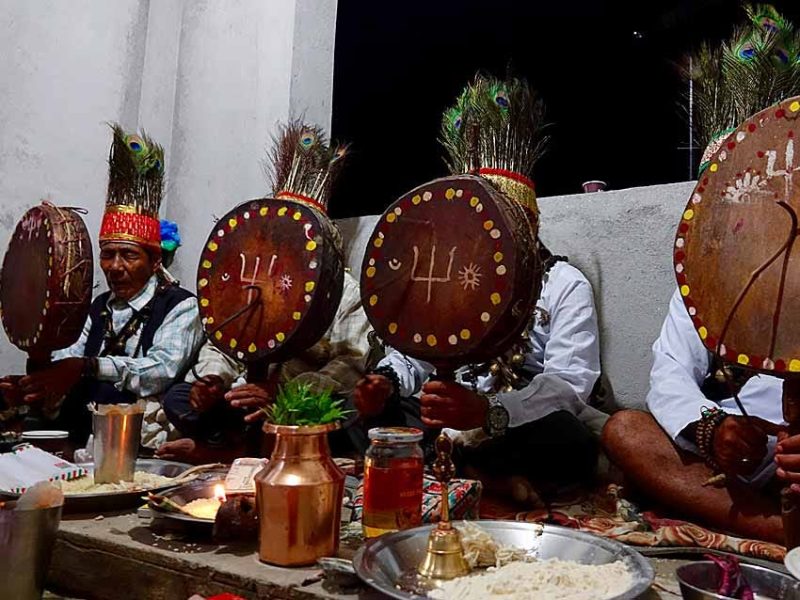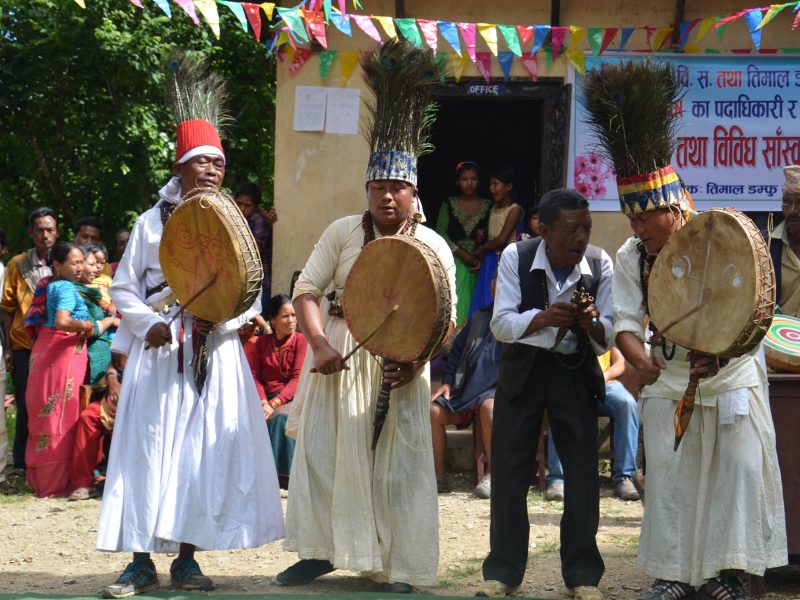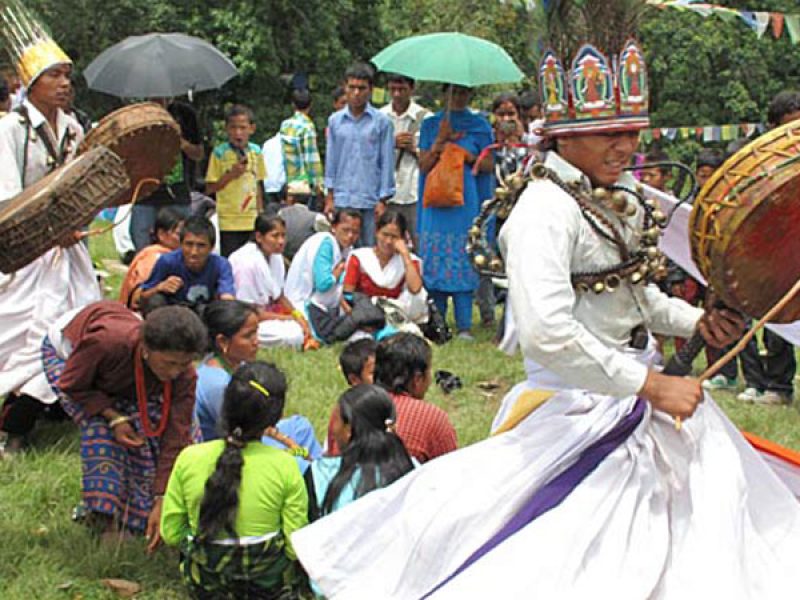Nepal, the home of Mount Everest is famous for its rich cultural inheritance and spiritual traditions. Being a country full of cultural and religious diversity, many traditions are being practiced here that give goosebumps to the viewers.
In the middle of such diverse tapestries of practices, the shamanism tour in Nepal stands out as a unique and fascinating sight. It takes you on a tour of spiritual power for the healing process. Unlike shamanism in other countries, this experience in Nepal gives you goosebumps with many magical and divine activities associated with it.
This blog delves into the amazing aspects of shamanism, inspecting the facts of its origination, rituals, and transformative experiences in the mystery land, of Nepal.
What Is Shamanism?
What Is The History Of Shamanism In Nepal?
Shamanism is not a new concept in Nepal. Well, this practice has been around for thousands of years and is older than Hinduism and Buddhism (religions). The shamans, also known as “Jhankri” or “Dhammi,” are spiritual healers (gurus) who use rituals with drums, chants, and dances to connect with souls or spirits.

In Nepal, this practice is more important to groups such as the Tamang, Gurung, Rai, Limbu, and Magar, and remains a big part of their culture and religion. Shamanism’s history in Nepal shows the unique blend of the country’s diverse cultures and traditions.
The Major Factors Of The Origination Of Shamanism In Nepal
- Old Inceptions: Shamanism in Nepal has been in practice for thousands of years. It used to be practiced by the indigenous people even before the arrival of Hinduism and Buddhism.
- Part of the Shaman: In Nepal, a shaman is also known as a “Jhankri” or “Dhammi.” The shamans are individuals who are believed to possess special powers to talk with spirits, thereby healing the sick and guiding the people.
- Customs and Rituals: Shamans often called Dhami or Jhakri perform various rituals to heal illnesses, protect communities, and ensure good fortune. Their healing process consists of drums, chants, and dances for entering trance states and communicating with the spirit world.
- Cultural Significance: It is also related to cultural aspects as it is especially prevalent among ethnic groups of Nepal such as the Tamang, Gurung, Rai, Limbu, and Magar. Without a doubt, cultural significance plays a crucial part in their social and religious lives giving a special place to shamanism.
- Communication with Other Religions: Over the years, shamanism practice in Nepal has coexisted and is sometimes seen being merged with Hindu and Buddhist practices. It is a fact that some rituals and festivals in Nepal include factors from all these traditions.
- Modern Era: In this modern era, it is still practiced in many rural/ village areas of Nepal. Though the practice has faced challenges due to modernization and the circulation of other religions, Shamanism remains an important part of Nepalese heritage and identity.
Therefore, shamanism in Nepal is widely known as an old and lasting tradition deeply rooted in the country’s cultural identity. Moreover, many communities still practice this tradition today.
Shamanism Tour In Nepal
Nepal is a wonderful option for the captivating world of shamanism. Here ancient traditions and mystical practices intertwine to depict a way of healing.
So guys buckle up to feel the spiritual experiences that go beyond ordinary reality. The experienced and well-skilled shamans guide you on this transformative journey of self-realization.
Further, the lap of the Himalayas also provides you with an opportunity to discover the profound wisdom of Nepal’s indigenous cultures. You will be able to witness mesmerizing rituals, rhythmic drumming, along with trance-like dances.

Giving a try to shamanism in Nepal further helps you embrace the opportunity to heal and rejuvenate. Yes, the visitors can participate in ancient healing practices and earn the blessings of benevolent spirits. There is a belief that complete soulful ceremonies, soul retrieval, and energy cleaning further help in experiencing the restoration of balance, harmony, and inner peace.
You should prepare to be moved, inspired, and forever changed by the enchanting world of shamanism that awaits you in the land of diversity.
The Attractions Of Shamanism For Tourists
Shamanism in Nepal is a fascinating blend of healing, communicating with spirits, and removing bad spirits. Here are some of the most notable practices:
- Spirit Possession: Shamans, known as “Jhankri” or “Dhami,” enter trance states during rituals, allowing spirits or deities to possess them. During this, they may speak in different voices, perform extraordinary acts, or convey messages from the spirit world.
- Soul Recovery: Shamans believe a person’s soul can be lost or stolen, causing illness or misfortune. They perform ceremonies to retrieve the lost soul from the spirit world, restoring health and well-being.
- Use of Herbal Remedies: Nepal’s rich natural diversity provides a variety of medicinal herbs and plants. Shamans use these traditional remedies, believed to have both physical and spiritual healing properties.
- Divination and Fortune Telling: Shamans are consulted for their ability to predict the future, heal illnesses, and offer guidance. Using tools like bones, stones, or water, they practice divination, believed to be accurate due to their spiritual power.
- Ritual Dances and Music: Shamans use drums, chanting, and dancing to enter altered states of consciousness and communicate with the spirit world. These rituals can be both frightening and exciting.
- Fire-Walking and Other Feats: Some shamans demonstrate their spiritual power by performing feats like fire-walking or piercing their bodies. These acts, which include putting hands inside boiling oil or walking on fire, showcase their spiritual protection and power.
These activities highlight the deeply spiritual and culturally rich practices of shamanism in Nepal, showcasing the shamans’ roles as healers, guides, and intermediaries between the human and spirit worlds.
Where Can You Witness The Shamanism Tour In Nepal?
You can witness the shamanism tour in Nepal mostly in place in the nearest districts of Kathmandu such as Nuwakot, Dhading, and Rasuwa. These places practice shamanism as they consist of huge numbers of villages and smaller wards than city areas.
Dhading, the district with the highest number of villages in Nepal. It has a separate village called Dhami Gau located near Dhading Besi. A huge number of shamans live together and practice their skills there.
Other villages in Udayapur districts and villages in hilly areas also observe Jhakri puja and mela. These occur during special occasions throughout the year. Similarly, Kathmandu Valley, Pokhara, and other major cities are also influenced by it though they practice this less.

The ritual is widely practiced in remote villages and some parts of rural Nepal are blindly following it. In places like Mustang, Sindhupalchok, Ramechhap Sailung, and Dolpo, different traditional healers adopt different methods as per their religion and community.
In addition, the variation in methods of shamanism as per different geographic areas and different communities adds a unique flavor of charm and divinity. These can give goosebumps to viewers, especially to the outsiders.
Frequently Asked Questions (FAQs)
1. What is the origin of shamanism?
Its origin dates back thousands of years, even before the existence of major religions like Hinduism and Buddhism. It began with indigenous people practicing spiritual healing and connecting with spirits to help their communities.
2. Is shamanism a religion?
Shamanism religion is not exactly like other organized religions. It is a spiritual practice and belief system. Shamans, or spiritual healers, communicate with the spirit world. They do this to heal people and offer guidance.
3. What are the symbols of shamanism?
Shamanism symbols include various items used by shamans during their rituals. These can be drums, feathers, stones, and other objects believed to have spiritual power and help in connecting with spirits.
4. What does shamanism mean?
It refers to a practice where shamans use spiritual methods to heal, protect, and guide people. It involves entering trance states to communicate with the spirit world and bring back messages or healing powers.
5. How does shamanism differ from other religions?
Unlike structured religions, it focuses on direct interaction with the spirit world through rituals and ceremonies. It does not have a set of written scriptures. Instead, it is more of a personalized and community-based spiritual practice.

Comment (0)